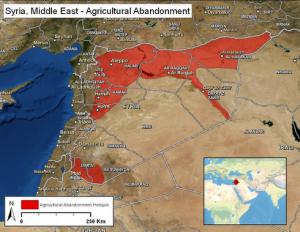Food securitySyria’s 1998-2012 drought likely its most severe in more than 900 years
In the years before the Syrian conflict erupted, the region’s worst drought on record set in across the Levant, destroying crops and restricting water supplies in the already water-stressed region. A new study shows that that drought, from 1998 to 2012, was not just the most severe in a century of record-keeping — it was the Levant’s most severe drought in at least 500 years and likely more than 900 years.

Area in red shows the extent of the Syrian dought // Source: umd.edu
In the years before the Syrian conflict erupted, the region’s worst drought on record set in across the Levant, destroying crops and restricting water supplies in the already water-stressed region. A new study shows that that drought, from 1998 to 2012, was not just the most severe in a century of record-keeping — it was the Levant’s most severe drought in at least 500 years and likely more than 900 years.
The study, published in the Journal of Geophysical Research: Atmospheres, is the first to quantitatively evaluate droughts across the Mediterranean region during the past 900 years at a high level of detail. It doesn’t identify a cause of the recent Syrian drought, but it does provide independent support for studies that have suggested global warming may already be having an effect there, said lead author Benjamin Cook, a climate scientist at Columbia University’s Lamont-Doherty Earth Observatory and NASA Goddard Institute for Space Studies.
“We can now say with some degree of confidence that what we’re seeing in that part of the Mediterranean is likely separable from natural variability,” Cook said. “If climate change is having an impact and is making droughts worse, then we should see this in the record over several centuries—and we do.”
—————————————————————————————————————-
Read also:
“Climate change and the origins of the Syrian war,” HSNW, 3 March 2015
“Climate change heightening the risk of conflict and war,” HSNW, 3 November 2015
—————————————————————————————————————-
Columbia U reports that Cook and his colleagues are among the first scientists to analyze data from the 2015 Old World Drought Atlas, which maps dryness and wetness year-by-year across the Mediterranean over the past millennium based on tree ring records. The results provide new insight into climate patterns that can help scientists develop better drought risk assessments and improve understanding both of the bounds of natural climate variability and what may be the emerging influence of greenhouse gases.
Drying in the Levant
Climate models suggest that the Levant is likely to grow drier as global temperatures rise. Some studies suggest that may already be happening. A 2015 study that linked the recent Syrian drought to the start of the civil war there determined that increasing levels of greenhouse gases from human activities like the burning of fossil fuels had likely increased the probability of such a severe and persistent drought in the region, making it two to three times more likely.
